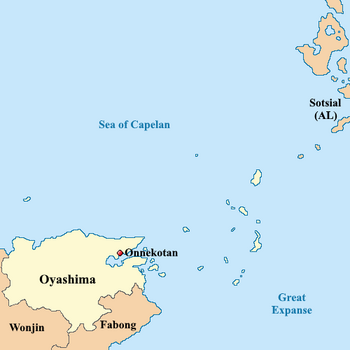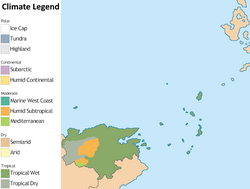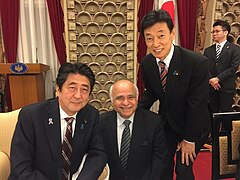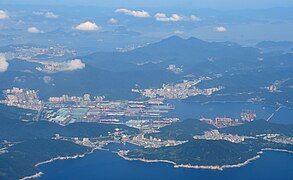Oyashima
| This article is a stub. You can help IxWiki by expanding it. |
State of Oyashima Oyashima Kokka (国家 むつとり) | |
|---|---|
Anthem: A Hundred Isles | |
 Map of Oyashima | |
| Capital | Onnekotan |
| Official languages | Oyash |
| Recognised regional languages | Mutsutori, Danehonger |
| Ethnic groups | Oyashi, Mutsutorine, Danehonger |
| Religion | Shinto, Confucianism, Mercantile Reform Protestantism |
| Demonym(s) | Oyashimane |
| Government | Elective Federal Constitutional Monarchy |
• Lord of Lords (Omo no Ryōshu/主の領主) | Koshamain Itakshir |
| Legislature | Assembly of Lords (Omo no shūkai/主の集会) |
| Area | |
• | 495,412.926 km2 (191,280.000 sq mi) |
| Population | |
• 2030 census | 37,435,619 |
• Density | 75.564/km2 (195.7/sq mi) |
| GDP (nominal) | estimate |
• Total | $1,178,959,949,167 $1.178 trillion |
• Per capita | $31,493 |
| Gini (2020) | 57.4 high |
| HDI (2024) | 0.691 medium |
| Currency | Yun (¥) |
| Time zone | UTC0 (time zone) |
• Summer (DST) | UTC+0 |
| Date format | dd-mm-yy |
| Driving side | right side |
| Calling code | 6-(860) |
| ISO 3166 code' | MU |
Oyashima is an industrialized and modern nation in northeastern Audonia, in the Dolong region. It is at the confluence of the Sea of Capelan and the Great Expanse. It is bordered in the southwest by Danehong, Metzetta in the southeast, and shares a maritime border with the Alstinian islands of Sotsial.
Oyashima is a elective federal constitutional monarchy. It has a unicameral legislature called the Assembly of Lords, a supreme court, and an executive, the Lord of Lords, the elected monarch.
It is a member of the League of Nations, the International Red Cross and Red Crescent Movement, and many other international organizations.
It has a strong market economy focused on exports, in collaboration with Burgundie whose companies have a stake in many of the country's export and shipping activities.
Many scholars have criticized its economic governance and politics, arguing that it is merely a client of the Burgoignesc thalattocracy's economic and cultural might.
The people of Oyashima are predominantly culturally Oyashi (with large minorities of Mutsutorine, Danehongers), speak Oyash, and most practice Shinto.
Demographics
Self-reported ethnic origin in Tapakdore (2030)
-
Danehongers
-
Danehong woman
-
Mutsutorine woman
-
Mutsutorine woman in traditional dress
-
Group of Mutsutorine women
-
Young Mutsutorine man
-
Older Mutsutorine man
-
Mutsutorine politicians
-
Oyashi woman in traditional dress
-
Oyashi family
-
Oyashi and Burgoignesc soldiers
Geography

Northern most point: 15.710N, Southern most point: 7.174N Oyashima has five types of climates: tropical wet, tropical dry, humid subtropical and Mediterranean (both are in higher-altitude areas) characterized by relatively high temperature, oppressive humidity and plenty of rainfall. There are two seasons in the country, the wet season and the dry season, based upon the amount of rainfall. This is also dependent on location in the country as some areas experience rain all throughout the year. Based on temperature, the warmest months of the year are March through October; the winter monsoon brings cooler air from November to February. May is the warmest month, and January, the coolest.
Climate and environment

| Category | Jan | Feb | Mar | Apr | May | Jun | Jul | Aug | Sep | Oct | Nov | Dec |
|---|---|---|---|---|---|---|---|---|---|---|---|---|
| Min | 20.67 | 20.57 | 21.09 | 21.98 | 22.55 | 22.35 | 22.03 | 22.07 | 21.97 | 21.76 | 21.64 | 21.31 |
| Mean | 24.72 | 24.88 | 25.71 | 26.68 | 27.02 | 26.47 | 25.94 | 25.92 | 25.9 | 25.83 | 25.65 | 25.21 |
| Max | 28.82 | 29.24 | 30.38 | 31.42 | 31.54 | 30.65 | 29.9 | 29.82 | 29.87 | 29.96 | 29.72 | 29.16 |
| Precipitation (mm) | 136.93 | 96.05 | 92.56 | 97.66 | 188.95 | 248.37 | 291.02 | 310.68 | 281.05 | 280.74 | 230.51 | 206.84 |
Relative humidity is high in Oyashima. A high amount of moisture or vapor in the air makes hot temperatures feel hotter. This quantity of moisture is due to different factors – the extraordinary evaporation from the seas that surrounds the country on northern and eastern sides, to the different Prevailing Winds in the different seasons of the year, and finally, to the abundant rains so common in a tropical country. The first may be considered as general causes of the great humidity, which is generally observed throughout the year. The last two may influence the different degree of humidity for the different months of the year and for the different regions of the archipelago.
The climate of the country is divided into two main seasons:
- the rainy season, from June to the early part of October;
- the dry season, from the later part of October to May. The dry season may be subdivided further into (a) the cool dry season, from the later part of October to February; and (b) the hot dry season, from March to May. The months of April and May, the hot and dry months when schools are on their long break between academic years, is referred to coloquially as "summer" (after the summer season which lasts from June to August in most countries).
| Months | November–February | March–May | June–August | September–October |
|---|---|---|---|---|
| Rainfall | Dry
|
Wet
| ||
| Temperature | Cool
|
Hot
| ||
| Season | Cool Dry
|
Hot Dry
|
Rainy
| |
History
Politics
Oyashima is governed by the Constitution of 1992, which inaugurated the period of constitutional monarchy under the leadership of the Omo no Ryōshu (Aenglish: Lord of Lords).
Executive
The roles of head of state and head of government are consolidated in the position of the Omo no Ryōshu, who acts as Speaker for the Assembly and chief executive. The Ryōshu's power is checked by the Assembly of Lords, and the budget is primarily decided by the Assembly.
Assembly
The Assembly of Lords is a unicameral legislature of 147 representatives elected by local direct first past the post elections; administrative regions are organized partly along island lines, partly along clan lines, and partly along municipal lines. This results in a very unbalanced spread of political power that is concentrated in seven of the eleven major islands of the nation. Terms are six years with no limit to the number of terms, and every two years, roughly a third of the legislature is put up for elections.
Political Factions
Political allegiance in Oyashima is better reflected by faction than party, as there are 86 registered parties, the most relevant of which operate in three broad wings: the conservative, minarchist Homeland faction, the urbanite and centrist Five Islands faction, and the rural and clan-based All Isles faction. Each of these contains a fluctuating web of parties, with the Five Islands being the dominant faction and the Homeland faction being the predominant opposition.
Economy
Oyashima is a mixed economy developed country with a high-income economy and is the one of the most industrialized countries in Audonia, behind only Daxia. Oyashimane brands are internationally famous and garnered Oyashima's reputation for its quality electronics, ship building, automobiles, armaments, and other manufactured goods. Oyashima is also considered a hospitable tropical paradise with tourism making up 6.2% of the nation's GDP. Its massive investment in education has taken the country from mass illiteracy to a major international technological powerhouse since the 1980s. This occured as a result of massive Burgoignesc financial and cultural investment during and after Operation Kipling. The country's national economy benefits from a young and highly skilled workforce and is among the most educated countries in the world with one of the highest percentages of its citizens holding a tertiary education degree. Oyashima's economy was one of the world's fastest-growing from the early 1960s to the late 1990s and was still one of the fastest-growing developed countries in the 2000s. The Oyashimane economy is heavily dependent on international trade, and the country has one of the world's largest foreign-exchange reserves. Major sectors include shipbuilding and repair, automotive manufacturing, electronics manufacturing, armaments manufacturing, tourism, mining, and construction. Agriculture is present in Oyashima but it is not a primary contributor to the national economy. Throughout its history, especially during
Manufacturing
Shipbuilding and repair
Automobiles
Electronics
Armaments
Tourism
Tourism is an important sector for the Oyashimane economy. The travel and tourism industry contributed 6.2% to the country's GDP in 2032. Coastal tourism, encompassing beach and diving activities, constitutes 25% of the Oyashima's tourism revenue, serving as its primary income source in the sector. As of 2032, 5.23 million Oyashimane were employed in the tourism industry and as of September 2033, Oyashima generated $5.5 billion in revenue from tourists, coming mostly from Burgundie, Arcerion, and Tierrador. The country attracts an average of 8,360,682 foreign visitors a year. In 2029, foreign arrivals peaked at 12,260,913. Popular activities include: beaching and diving, hiking, biodiversity research and education, arts and crafts tourism, festivals, and eastern medical tourism. The most popular destinations are the white sand beaches of the northern coast and the island for local and foreign visitors. The western plateau on the mainland has become a popular hiking destination. The plateau has a wide range of flora and fauna, including over 272 bird species, 111 of which are endemic to the area.
Mining and mineral extraction
Construction
Infrastructure
Rail
Oyashima uses Standard gauge, 1,435 mm (4 ft 8+1⁄2 in) as most of its rail infrastructure has been under the auspices of Burgundie and its sphere of influence in the Audonia, who all use that rail gauge.























